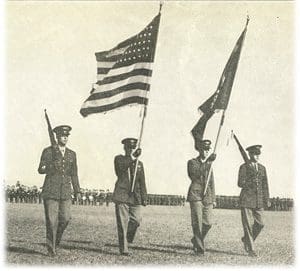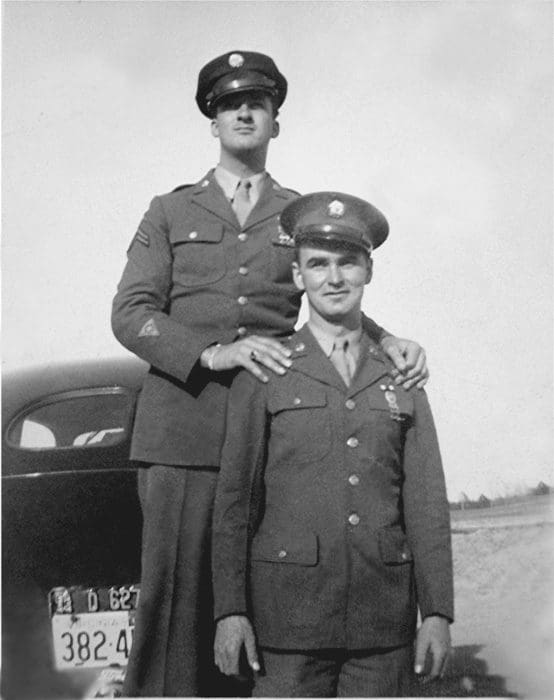
Many family members served in the United States Armed Forces during World War II. Fortunately, family members have preserved some of the experiences they had during the great conflict. The unassuming and humble demeanor of the individuals who served belied their brave and heroic actions. To help us better appreciate the actions and sacrifices made for all of us, here we share some of their stories.

These stories are placed in the order contributed by various family members, and other than that, the order has no significance.
Louis L. Oddenino's World War II experience can be found by clicking here.

Louis L. Oddenino and Robert N. Eaheart, two Virginia
country boys, friends, and brothers-in-law, proudly
posing in their uniforms during World War II
Robert N. Eaheart
Robert N. Eaheart joined the United States Army on November 18, 1942. He was assigned to General George S. Patton’s Third Army 10th Armored Division, which was activated on July 15, 1942, at Fort Benning, Georgia. The 10th Armored Division (nicknamed Tiger Division) was an armored division of the United States Army during World War II.
The 10th Armored Division entered France through the port of Cherbourg on September 23, 1944, and put in a month of training at Teurtheville, France, before entering combat. Leaving Teurtheville on October 25, the Division moved to Mars-la_Tour, where it entered combat on November 1 in support of the XX Corps, combatting enemy troops in the area. In mid-November, it went on the offensive, crossed the Moselle at Mailing, and drove to the Saar River, north of Metz. The Division was making preparations for the Third Army drive to the Rhine when it was ordered north to stop the German winter offensive on December 17. The 10th Corps held defensive positions against heavy opposition near Bastogne, Noville, and Bras. Despite determined German attacks, the Allied perimeter was held.
In December 1944, Robert N. Eaheart's Tank Division found itself in the forested Ardennes Mountain region of Belgium, just outside of Bastogne. The German high command had launched a Major Offensive, which caught the Allied forces by surprise. The battle would later be known as the Battle of the Bulge. The 110th regiment's situation was by far the worst, as it was responsible for an eleven-mile front, while its 2nd battalion was withheld as the divisional reserve. German Panzer columns took the outlying villages and widely separated strong points in bitter fighting, and advanced to points near Bastogne within four days. The hotly contested struggle for the villages saw the Americans determinedly holding their positions, while transport confusion on the German side slowed the German offensive sufficiently to allow the 101st Airborne Division (reinforced by elements from the 9th and 10th Armored Divisions) to reach Bastogne by truck on the morning of 19 December. The fierce defense of Bastogne, in which American paratroopers particularly distinguished themselves, made it impossible for the Germans to take the town with its important road junctions.
By 21 December, the German forces had surrounded Bastogne, which was defended by the 101st Airborne and Combat Command B of the 10th Armored Division. Conditions inside the perimeter were tough—weather was the worst in decades, temperatures were sub-zero, and most of the medical supplies and medical personnel had been captured. Food was scarce, and by December 22, artillery ammunition was restricted to 10 rounds per gun per day. Fortunately, the weather cleared the next day, and Allied supplies (primarily ammunition) were dropped over four of the next five days.
The Germans failed to meet their objectives. In the wake of the failure, many experienced German units were left severely depleted of men and equipment as survivors retreated to the defenses of the Siegfried Line. The Allied side suffered widely as well, with this being the single largest and bloodiest battle that American forces experienced in World War II.
During one of the many firefights in and around Bastogne, Robert N. Eaheart was pinned down by enemy fire as he sought safety in a water-filled tank track. If he moved, he risked exposing his body to enemy fire. Compelled to make the water-filled depression his temporary quarters, he remained there with ice forming around his neck until nightfall. The Darkness allowed him to return to the safety of his lines.
Winston Churchill, addressing the House of Commons following the Battle of the Bulge, said, "This is undoubtedly the greatest American battle of the war and will, I believe, be regarded as an ever-famous American victory".
The 10th Armored Division was inactivated on October 13, 1945, at Camp Patrick Henry in Virginia. It was reactivated as a reserve unit in 1946 and deactivated for the final time in 1957.

